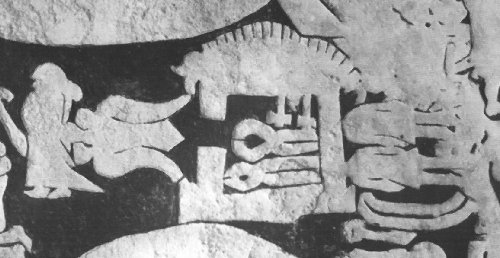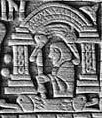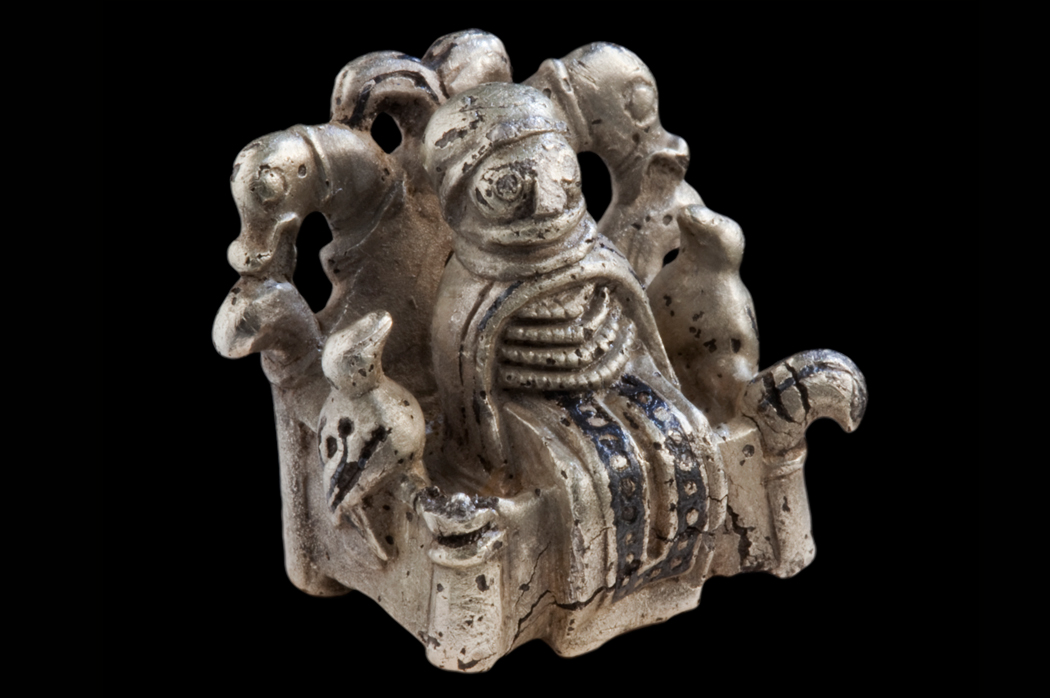|
The automatic translation is necessarily imprecise. This translation does not replace the reading of German or English original texts.
432000 Einherjer behind Valhalla's 540 Gates
A well known famous archer, Ægil is defending a fortification, a stonewall construction with battlements (here tilted to the side), a rare sight those days. The site of the fortress is sacred ground as the two valknutr behind the building designate. They are – in the very sense of the word – Woden’s hallmark. The aggressors seem to have successfully intruded into the outer court. They are within the curtain walls indicated by the salient battlements.
 It is the "naïve viewpoint" of the early Middle Ages which shows the walls in elevation (cf. Ardre VIII).The archer is standing in the doorway, not - as modern architecture may insinuate - behind a window. This door was safely protected by a metal fitting, some kind of a shield, may be, which was mounted onto the blank space. Now, if the missing two parts had carried Valhalla's roof, made of silver shields, this disk may have carried a golden sun wheel, the sun in his zenith over Asgard. The picture seems to reflect the lines from the Grimnirsmal:
It is the "naïve viewpoint" of the early Middle Ages which shows the walls in elevation (cf. Ardre VIII).The archer is standing in the doorway, not - as modern architecture may insinuate - behind a window. This door was safely protected by a metal fitting, some kind of a shield, may be, which was mounted onto the blank space. Now, if the missing two parts had carried Valhalla's roof, made of silver shields, this disk may have carried a golden sun wheel, the sun in his zenith over Asgard. The picture seems to reflect the lines from the Grimnirsmal:
Svalin is called, the Sun before,
a shield from the shining god.
Would smoke and smolder both sea and land,
if from him it ever should fall.
It may hold some significance that the archer and the lady behind him are back to back with the H-Panel. If that one was the last in a sequence from Birth to Death, this one is the celestial fulfilment.
The bowman has already shot 5 arrows and holds 2 more ready to shoot, at the aggressors approaching from the left side. Behind him there is a person under an arch supported by columns, who is generally regarded as a female. If so, she is most likely his fylgja, the battle helping Valkyrie with one more arrow in her hand. And if this picture is based on a similar state of tradition as behind the Völundarkviða in the Edda, she may be his swan maiden spouse:
 Three maidens through Mirkwood flew,
Three maidens through Mirkwood flew,
Fair and young, fate to endure...
Olrun was the first; she took Egil for lover.
Swanwhite the second: she took Slagfidur.
Hervor the third; she threw round
Völund's white neck wanton arms.
Having a closer look at the arch construction, we detect its similarity with the throne on the picture of the Magi. Such constructions are frequent in early medieval manuscripts like the Lindisfarne Gospels, where they mark the thrones of kings chairs or of saints like Mark or John etc., often identified by their particular animal, eagle or lion in this case.
  As ‘throne’ and ‘high seat’ are in OE the same, i.e. ‘giefstol’ or ‘setl’, this accommodation may be Woden/Odin’s Hliðskjálf1, his famous high seat. In fact, while two valknutr mark the entire site as sacred, the third one refers to this particular detail. So, as S. Pollington has suggested, it seems very likely that it is Woden himself, directing the defence of Valhalla. If so, he would be holding his spear Gungnir in his hand. This interpretation is underlined by the two sets of double-headed animals above and below him.
As ‘throne’ and ‘high seat’ are in OE the same, i.e. ‘giefstol’ or ‘setl’, this accommodation may be Woden/Odin’s Hliðskjálf1, his famous high seat. In fact, while two valknutr mark the entire site as sacred, the third one refers to this particular detail. So, as S. Pollington has suggested, it seems very likely that it is Woden himself, directing the defence of Valhalla. If so, he would be holding his spear Gungnir in his hand. This interpretation is underlined by the two sets of double-headed animals above and below him.
According to the Grimnir verses wolf and eagle are the marks of Valhalla:
Easily known to Ygg's chosen
are the heavenly halls:
A wolf hangeth o'er the western gate,
and hovers an eagle on high.
 Thron-Amulett-(Lejre-in-2009) Thron-Amulett-(Lejre-in-2009)
Photo-courtesy-Ole-Malling-Roskilde-Museum.
The amulet from Lejre (about 900 AD) seems to support this interpretation. This sculpture made of silver and niello – only 17,5 mm high – shows a person on a throne, flanked by two ravens. It most likely represents Woden/Oðin and his messengers Hugin (memory) and Munin (thought). 1a Two other animal heads forming the back-rest of the chair will stand for the God’s two wolves, Geri and Freki (Old Norse, both meaning "the ravenous" or "greedy one"). Very much like our picture here, they are part of the seat, but not just as mere decoration. As an attribute of the Deity they are functional, especially as they are part of an amulet, which is believed to bear apotropaic power.
Not only wolf and raven mark the sacred place as Valhalla, but also the fortification itself, as we can tell by what the Grimnirsmal gives away:
Five hundred doors and forty withal
I ween that in Valhalla be:
eight hundred warriors through one door hie them
when they fare forth to fight the Wolf.
Woden/Odin's eschatological army as we learn, comprises 540 x 800 warriors, a total of 432000 men ready to fight on the side of the gods in the final battle. If the Ægil picture refers to Valhall these figures be reflected there, and if so, in their basic relation of 54 and 8.2
18 battlements (2 at each small side and 7 at each long side) are attached to the fortification. These elements were originally composed of 3 "bars" each, which would have produced 54 bars, the "basic number" behind 540. This result could have been accidental, but a mishap and the attempt to even it out prove the numeric intention: A bone fragment, bearing the top bar of four of the battlements and a part of the Woden's knot next to them, had broken off.  In order to even it out the carver (or someone familiar with his plan) subdivided two of the three remaining battlements into five bars each, which made up for the loss. In order to even it out the carver (or someone familiar with his plan) subdivided two of the three remaining battlements into five bars each, which made up for the loss.
As there are 800 warriors behind each door, ready to dash out in order to defend Asgard against the frost giants (Jötunn or hrimthurs), they may also be rendered here in a symbolic way and by their "basic number" 8. As the fight is going on they should be found on the battleground. We may well see them in the 8 arrows, 5 of which are already causing a problem to the attackers, while the remaining 3 are still in the hands of the archer and his fylgja.2
Looking at the giants again, we may wonder whether their number is 7 or 8, depending on the swordsman hitting a giant and leaving in the opposite direction. Is he a deserter or an audacious member of the Æsir? Whatever, the situation of the attackers is hopeless. Two of them, the naked bodies, seem to be dead, two other ones are about to be hit by the arrows while we can look behind the shields of the remaining ones.
 
Six Pictures - one Programme
The sequence of pictures, which set off with "Birth" (Magi) and "Partnership" (Welund) and continued with the "Way to war" (Romulus) culminated in "Victory and Glory" (Titus). These three luck providing charms were meant to secure a glorious and victorious life. The fourth panel (Herh-Os) deals with the proper kind of "Death": When there is Death, it is to be the proper kind of Death, meaning death on the battlefield rather than on the palliasse. A heroic death qualifies the warrior for an afterlife at Valhalla. And that is what (quite properly) the lid (Ægili) shows.
This way the sequence of scenes from history and mythology is made to help the "way of wyrd" in favour of the owner of the (probably) royal hoard box.
It may be only of philosophical interest, but it casts a light on the pagan Germanic view on life: The luck providing three panels seem to be under the influence of the lunar rosette spelling birth and life as the way to death (Magi) while Valhalla means real and everlasting life. Thus it seems likely, at least possible, that a golden sun swirl had shone over the picture of Ægil's Valhalla.3
1
In Norse mythology, Hliðskjálf (sometimes Anglicized Hlidskjalf; English: "high-gate") is the high seat of Odin enabling him to see into all worlds.
In Grímnismál, Odin and Frigg are both sitting in Hlidskjálf when they see their foster sons Agnar and Geirröd, one living in a cave with a giantess and the other a king. Frigg then made the accusation to her husband that Geirröd was miserly and inhospitable toward guests, so after wagering with one another over the veracity of the statement Odin set out to visit Geirröd in order to settle the matter.
In Skírnismál, it is Freyr who sits in Hlidskjálf when he looks into Jötunheim and sees the beautiful giant maiden Gerd, with whom he instantly falls in love.
In Gylfaginning, Snorri mentions the high seat on four occasions. In the first instance he seems to refer to it rather as a dwelling place: "There is one abode called Hlidskjálf, and when Allfather sat in the high seat there, he looked out over the whole world and saw every man's acts, and knew all things which he saw." However, later he explicitly refers to it as the high seat itself: "Another great abode is there, which is named Valaskjálf. Odin possesses that dwelling. The gods made it and thatched it with sheer silver, and in this hall is the Hlidskjálf, the high seat so called. Whenever Allfather sits in that seat, he surveys all lands." The third mention made of Hlidskjálf is during Snorri's recounting of the wooing of Gerd, quoted by him from Skírnismál. Lastly, Snorri relates how Odin used the high seat to find Loki after he fled from the scene of his murder of Baldr.
Attributes and symbols of Woden/Odin: Wild Hunt, Valhalla, Einherjar, Hugin and Munin, Sleipnir, Geri and Freki, Hlidskjalf, Gungnir, Valknut
Source: Wikipedia
1a Dazu Marijane Osborn, „The Ravens on the Lejre Throne” in: Representing Beasts in Early Medieval England and Scandinavia (2015), S. 94 – 112. According to the author the two heads forming the back are mere ornament, but she refers to Carl Anderson, who sees Woden’s wolves in them. [„The Backrest Beasts of Oðinn from Lejre Society for Medieval Archaeology Newsletter” 44 (October 2010) 7-8.]
2 The 10- or 100fold defines the value rather in quality than in quantity. If, for example 3 is good, 30 is better and 300 is best. S. O. Reuter, Der Himmel über den Germanen (1936), S.42 f says: "Eine Teilung in 8, 16 und 27 zeigt schon die Kultscheibe des bronzezeitlichen Himmelswagens von Trundholm aus Westschweden, wo die zahlreichen Radkreuze auf den Felsbildern ähnliche Teilung zeigen. In geschichtlicher Zeit erscheint diese Teilung in einem astronomischen Bruchstück der Edda,m das für die himmlische Walhall 540 Golfe und Tore mit je 800 Einheerern, die, zusammen 432000, im Ende des Menschenalters (verold = Welt) gegen die eindringende Zerstörung eingesetzt werden sollen. Da die Verzehn- und Verhundertfachung auch sonst als germanisches Kunstmittel bezeugt ist, sind die ursprünglichen Zahlen des Himmelskreises 54 und 8; sie bilden die Sonnen- und Mondbahnteilung in dem gemeinschaftlichen Vielfachen 432000, die in gleichem Sinn Altindien angehört ..."
Hans Naumann, "Die Zahl 432000" goes further than that: "... die Zahl 432000 ist eine charakteristische Zahl der hellenistisch-orientalischen Zeitenmystiksysteme, die ihre Quelle, soweit wir sehen, im Babylonischen finden. Wir geraten mit dieser Zahl in die babylonische Weltzeitalterlehre, die Aeonenlehre, die Lehre vom großen Weltjahr, vom Aion. Der babylonische Mardukpriester Berossos aus der Diadochenzeit hat die Zahl 432000 überliefert für den Aion der vorsintflutlichen Könige. Die Weltjahrzahlenspekulation Indiens kennt die Zahl 432000 für das Kaliyuga, mit 10 multipliziert gibt sie sie für des Mahayuga an. Sie liegt dem ganzen Yugasystem zugrunde und sie begegnet mit 3 Dekaden multipliziert auch in der platonischen Zahl 12960000 : 432000 ist das Dreißigstel der platonischen Zahl im achten Buch von Platons Staat. Man kann sagen, nach einem bestimmten System der hellenistisch-orientalischen Aeonenlehre dauert ein Aion 432000 Jahre; sind sie um, so ist eine Weltperiode zu Ende.
Man weiß nun schon längst, daß diese auffällige Zahl mit der Zahl der Walhallkrieger zusammenhängen muß, daß es sich um ein entlehntes Trümmerstück jener Aeonenlehre handelt, im Zusammenhang mit andern Trümmern nach Germanien verschlagen. Jeder Zufall ist ausgeschlossen. Eine so ungewöhnliche Zahl wird nicht zweimal verschiedenen Ortes, noch dazu in verwandter Funktion, erfunden. Wo die Zerlegung der Zahl in 540 und 800 erfolgte, darüber wird sich kaum etwas ausmachen lassen. Orientalisch-hellenistischer wäre die andre Zerlegung mit der bedeutungsschwereren Zahl 72 gewesen, 600 mal 720 gleich 432000."
Dazu paßt der Eintrag aus dem Damen Conversations Lexikon, Band 7. [o.O.] 1836, S. 334-349 zu "Mythologie": "Im alten Italien waren die Etrurischen Staaten am mächtigsten, ausgebildetsten, und hatten eine zahlreiche Priesterschaft. Diese lehrte von der Weltschöpfung und dem Kreise der Zeit: Der Demiurg schuf in 6000 Jahren die Welt, Himmel und Erde, Firmament und Meer, Sonne und Mond, Thier- und Menschenseelen. Andere sechstausend Jahre lang dauert das Menschengeschlecht; nach Ende des zwölftausendjährigen Weltjahres beginnt eine neue Schöpfung. Gott hieß Aesar (an die Asen der scandinavischen Mythe erinnernd), Tina war die Weltseele, Natur, Schöpferhauch."
3 This symbol can be found on pagan (Gothland's picture stones)as well as on christian monuments.
|

 It is the "naïve viewpoint" of the early Middle Ages which shows the walls in elevation
It is the "naïve viewpoint" of the early Middle Ages which shows the walls in elevation  Three maidens through Mirkwood flew,
Three maidens through Mirkwood flew, 
 As ‘throne’ and ‘high seat’ are in OE the same, i.e. ‘giefstol’ or ‘setl’, this accommodation may be Woden/Odin’s Hliðskjálf
As ‘throne’ and ‘high seat’ are in OE the same, i.e. ‘giefstol’ or ‘setl’, this accommodation may be Woden/Odin’s Hliðskjálf Thron-Amulett-(Lejre-in-2009)
Thron-Amulett-(Lejre-in-2009)  In order to even it out the carver (or someone familiar with his plan) subdivided two of the three remaining battlements into five bars each, which made up for the loss.
In order to even it out the carver (or someone familiar with his plan) subdivided two of the three remaining battlements into five bars each, which made up for the loss. 




